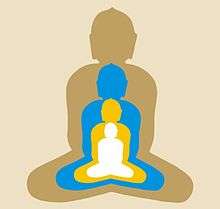Jīva (Jainism)
| Part of a series on |
| Jainism |
|---|
 |
|
Jain prayers |
|
Ethics |
|
Major figures |
|
Major sects |
|
Festivals |
|
Pilgrimages |
|
|
The Jīva or Atman (/ˈɑːtmən/; Sanskrit: आत्मन्) is a philosophical term used within Jainism to identify the soul. It is one's true self (hence generally translated into English as 'Self') beyond identification with the phenomenal reality of worldly existence. Jain philosophy is the oldest Indian philosophy that separates body (matter) from the soul (consciousness) completely.[1] As per the Jain cosmology, jīva or soul is the principle of sentience and is one of the tattvas or one of the fundamental substances forming part of the universe. According to The Theosophist, "some religionists hold that Atman (Spirit) and Paramatman (God) are identical, while others assert that they are distinct ; but a Jain will say that Atman and Paramatman are identical as well as distinct."[2] In Jainism, spiritual disciplines, such as abstinence, aid in freeing the jīva "from the body by diminishing and finally extinguishing the functions of the body."[3] Jain philosophy is essentially dualistic. It differentiates two substances, the self and the non-self.[4]
Soul substance
Jains regard soul as one of the six fundamental and eternal substances (dravyas) which forms the universe. The two states of soul substance are mentioned in the Jain texts. These are — Svābhva (pure or natural) and Vibhāva (impure or unnatural state). Souls in transmigration are in impure state and liberated ones are said to be in natural or pure state.[5]
Souls in transmigration


According to Jain philosophy, souls in transmigration are liable to be reborn in four gatis (states of existence), namely, Heavenly being (deva), Human (manushya), hell being (naraki) and animals and plants (triyancha).[6] Besides this there also exist a sub-microscopic life form, Nigoda, possessing only one sense, i.e., of touch.[7]
Real Self
According to the Jain text, Samayasāra (The Nature of the Self):-
Jiva (soul) which rests on pure faith, knowledge, and conduct, alone is the Real Self. The one which is conditioned by the karmic matter is to be known as the impure self.
It also mentions that only arihant and siddha are the real self.[8]
Stages of spiritual development
Jain texts explain that there are fourteen stages of spiritual development called Gunasthana. These are:[9]
- Mithyadristi: The stage of wrong believer
- Sasādana: downfall from right faith
- Misradrsti: mixed right and wrong belief
- Avirata samyagdrsti: vowless right belief
- Deśavirata: The stage of partial self-control
- Pramattasamyata: Slightly imperfect vows
- Apramatta samyata: Perfect vows
- Apūrvakaraņa: New thought-activity
- Anivāttibādara-sāmparāya: advanced thought-activity (Passions are still occurring)
- Sukshma samparaya: slightest delusion
- Upaśānta-kasaya: subsided delusion
- Ksīna kasāya: destroyed delusion
- Sayogi kevali: Omniscience with vibration
- Ayogi kevali: The stage of omniscience without any activity
See also
- Ratnatraya- Three Jewels of Jainism
- God in Jainism
- Atma Siddhi
- Atman (Buddhism)
- Atman (Hinduism)
Notes
- ↑ "dravya - Jainism". Encyclopedia Britannica.
- ↑ The Theosophist. Theosophical Publishing House. 1609. p. 553.
For instance, some religionists hold that Atman (Spirit) and Paramatman (God) are one, while others assert that they are distinct; but a Jain will say that Atman and Paramatman are one as well as distinct.
- ↑ Hubbard, Jamie; Swanson, Paul Loren (1997). Pruning the Bodhi Tree: The Storm Over Critical Buddhism. University of Hawaii Press. p. 246. ISBN 9780824819491. Retrieved 19 February 2013.
For the Jains, therefore, ascetic practices such as fasting and the like serve to liberate the spirit (atman) from the body by diminishing and finally extinguishing the functions of the body.
- ↑ Jaini 2013, p. 1.
- ↑ Kundakunda, Acharya; Chakravarti, Appaswami; Upādhye, Ādinātha Neminātha (2001). Ācārya Kundakunda's Pañcāstikāya-sāra. p. 16. ISBN 978-81-263-1813-1.
- ↑ Jaini 1998, p. 108.
- ↑ Jaini 1998, p. 109.
- ↑ Jain 2012, p. 3.
- ↑ Jain, Vijay K (2014-03-26). Acarya Pujyapada's Istopadesa – the Golden Discourse. p. 14. ISBN 9788190363969.
References
- Jaini, Jagmander Lal (2013), Outlines of Jainism, Cambridge University Press, ISBN 978-1-107-61567-0
- Jain, Vijay K. (2012), Acharya Kundkund's Samayasara, Vikalp Printers, ISBN 978-81-903639-3-8,
Non-Copyright
- Jaini, Padmanabh S. (1998) [1979], The Jaina Path of Purification, Delhi: Motilal Banarsidass, ISBN 81-208-1578-5